

|
| DEUTSCHLAND | GERMANY |
| Bundesland: Sachsen-Anhalt | Saxony-Anhalt |
| Stadt: Halle (Saale) |
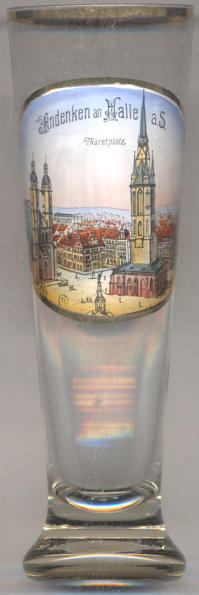
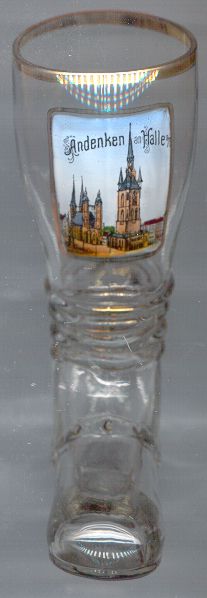 Halle (Saale) is situated at an elevation of 105 m on the river Saale and is the largest city (ca. 250,000 inhabitants) of Sachsen-Anhalt.
The first mention of a castle ad locam qui vocatur Halla is found in a document of AD 806. The word 'Halle' most probably is derived
from the celtic word 'hal' (salt). A saline spring is already mentioned in a document of 961. From 968 on, Halle belonged to the newly-founded
archdiocese of Magdeburg. The first privileges granting the rights as a market town were issued in 984. Already in 1281,
Halle is mentioned as member of the Hanse federation of trading towns. Since 1503, the archbishops of Magdeburg resided in Halle.
The archdiocese lost its independence in 1860 when it became part of the Electorate of Brandenburg (1701 Kingdom of Prussia). The university of Halle,
founded in 1694, was united with the old university of Wittenberg in 1817; its official name 'Martin-Luther-Universität Halle-Wittenberg' was introduced in 1933.
In 1947/48, Halle became the capital of the state of Sachsen-Anhalt. After the dissolution of the states within the German Democratic Republic in 1952,
Halle became capital of the Halle district. Since the re-unification of Germany in 1990, Halle is again part of the newly-formed state of Sachsen-Anhalt
(the capital now is Magdeburg).
Halle (Saale) is situated at an elevation of 105 m on the river Saale and is the largest city (ca. 250,000 inhabitants) of Sachsen-Anhalt.
The first mention of a castle ad locam qui vocatur Halla is found in a document of AD 806. The word 'Halle' most probably is derived
from the celtic word 'hal' (salt). A saline spring is already mentioned in a document of 961. From 968 on, Halle belonged to the newly-founded
archdiocese of Magdeburg. The first privileges granting the rights as a market town were issued in 984. Already in 1281,
Halle is mentioned as member of the Hanse federation of trading towns. Since 1503, the archbishops of Magdeburg resided in Halle.
The archdiocese lost its independence in 1860 when it became part of the Electorate of Brandenburg (1701 Kingdom of Prussia). The university of Halle,
founded in 1694, was united with the old university of Wittenberg in 1817; its official name 'Martin-Luther-Universität Halle-Wittenberg' was introduced in 1933.
In 1947/48, Halle became the capital of the state of Sachsen-Anhalt. After the dissolution of the states within the German Democratic Republic in 1952,
Halle became capital of the Halle district. Since the re-unification of Germany in 1990, Halle is again part of the newly-formed state of Sachsen-Anhalt
(the capital now is Magdeburg).
The most famous son of Halle certainly is the Baroque composer Georg Friedrich Händel (1685–1759).
The music festivals 'Händel-Festspiele' were founded in 1952 and are a centre of the cultural life of the town.
A series of 29 drawings and 11 paintings of architectural motifs of Halle (in part commissioned by the city of Halle in 1929) were done by the
american cubist painter Lyonel Feininger (1871–1956).
The  Marktkirche "Unser Lieben Frauen" (Market or Lady Church) [left] with its characteristic four towers
is one of the landmarks of Halle. The church was built in 1529–1554 in Late Gothic style in place of two earlier churches of which only the towers
remained. The Gothic west spires (Blaue Türme, 'blue towers') and the Late Romanesque east towers (Hausmannstürme) had already been part of
the churches Sankt Gertrauden (originally dating back to Karolingian times) and Sankt Marien (first mentioned in the 12th century). Martin Luther
preached in this church three times in 1545 and 1546. Wax molds of his hands and face, taken after his death, are still kept in the sacristy of the church.
The large organ was built in 1716; the first to play the organ was the famous Johann Sebastian Bach.
Georg Friedrich Händel (1685–1759) learnd to play the organ on this instrument.
Between 1746 and 1764, Friedemann Bach held the position of organist.
Marktkirche "Unser Lieben Frauen" (Market or Lady Church) [left] with its characteristic four towers
is one of the landmarks of Halle. The church was built in 1529–1554 in Late Gothic style in place of two earlier churches of which only the towers
remained. The Gothic west spires (Blaue Türme, 'blue towers') and the Late Romanesque east towers (Hausmannstürme) had already been part of
the churches Sankt Gertrauden (originally dating back to Karolingian times) and Sankt Marien (first mentioned in the 12th century). Martin Luther
preached in this church three times in 1545 and 1546. Wax molds of his hands and face, taken after his death, are still kept in the sacristy of the church.
The large organ was built in 1716; the first to play the organ was the famous Johann Sebastian Bach.
Georg Friedrich Händel (1685–1759) learnd to play the organ on this instrument.
Between 1746 and 1764, Friedemann Bach held the position of organist.
The  Red Tower (Roter Turm) [right] (80 m high), another landmark of the town, was built between 1418 and 1506. The lower parts of the tower
date back to a Romanesque construction of around 1150. It is the only example of a freestanding bell tower in Germany. A neo-gothic annex of 1825
was removed in 1946 after the tower was severly damaged by a fire in 1945, the restoration of the roof began in 1975. Since 1993,
the tower holds the world's largest carillon (81 bells, total weight 46,500 kg).
Red Tower (Roter Turm) [right] (80 m high), another landmark of the town, was built between 1418 and 1506. The lower parts of the tower
date back to a Romanesque construction of around 1150. It is the only example of a freestanding bell tower in Germany. A neo-gothic annex of 1825
was removed in 1946 after the tower was severly damaged by a fire in 1945, the restoration of the roof began in 1975. Since 1993,
the tower holds the world's largest carillon (81 bells, total weight 46,500 kg).
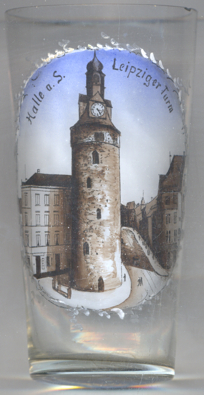 The
The  Leipziger Turm ('Leipzig Tower') [near left, no.͇3632]
was built in the 15th century next to the former Galgentor (gallow gate, demolished in 1819) of the old town's
foritifications. The Leipzig Tower thus also was known as 'Galgtorturm'. The free-standing tower has a height of
44 metres and served as a watch tower. The wall of the lower parts of the tower has a thickness of 2.8 metres.
In 1573 a Renaissance roof and a clock were added.
Leipziger Turm ('Leipzig Tower') [near left, no.͇3632]
was built in the 15th century next to the former Galgentor (gallow gate, demolished in 1819) of the old town's
foritifications. The Leipzig Tower thus also was known as 'Galgtorturm'. The free-standing tower has a height of
44 metres and served as a watch tower. The wall of the lower parts of the tower has a thickness of 2.8 metres.
In 1573 a Renaissance roof and a clock were added.
[https://de.wikipedia.org/wiki/Leipziger_Turm]
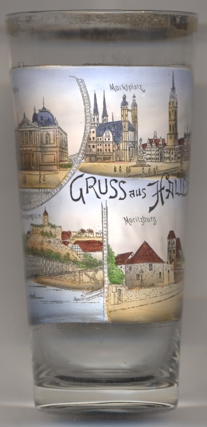 The former
The former  municipal theatre [far left: no. 4066, and below left, no. 2713: top left pictures]
was built by the architect Heinrich Seeling and opened in 1886 under the name Stadttheater Halle. On 31 March 1945 the theatre was almost completely
destroyed during an Allied bomb raid. After the war, the theatre was rebuilt and reopened in 1951 under the name Landestheater Halle.
In 1992 it was renamed to its current title Oper Halle. The theatre is currently used for performances of opera, ballet, plays, and orchestral concerts.
It is also the main performance venue for the annual summer Handel Festival held in the city.
municipal theatre [far left: no. 4066, and below left, no. 2713: top left pictures]
was built by the architect Heinrich Seeling and opened in 1886 under the name Stadttheater Halle. On 31 March 1945 the theatre was almost completely
destroyed during an Allied bomb raid. After the war, the theatre was rebuilt and reopened in 1951 under the name Landestheater Halle.
In 1992 it was renamed to its current title Oper Halle. The theatre is currently used for performances of opera, ballet, plays, and orchestral concerts.
It is also the main performance venue for the annual summer Handel Festival held in the city.
[https://de.wikipedia.org/wiki/Oper_Halle, http://en.wikipedia.org/wiki/Halle_Opera_House]
The top right pictures on glass no. 4066 [left] and no. 2713 [below left] show a view of the
 Market Square
Market Square
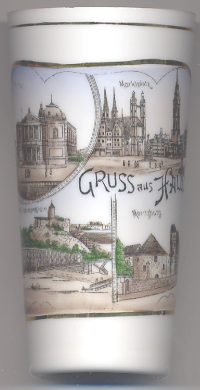
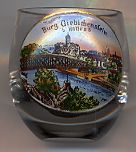
 Giebichenstein castle [far left: no. 4066, and near left, no. 2713: bottom left pictures; and right: no. 2585]
was the first of the numerous castles that had been erected
along the course of the river Saale. A castle (castrum Givekenstein) was already mentioned in a document of 1116, but this was not identical
with Giebichenstein castle. The present castle was probably founded in the 12th century when the archbishops of Magdeburg
had incoprated the area into their territory. From 1382 onward, the castle was the main residence of the archbishops. The lower castle was
built in 1445–1464. However, Archbishop Ernst of Saxony, brother of Elector Friedrich III ('the Wise'), chose to build a new residence in Halle,
Moritzburg castle. When Moritzburg castle had been finished in 1503, Giebichenstein castle lost its role as residence castle and was used as
the administrative centre. From 1514 onward, the upper castle began to fall into dereliction. A new, Baroque, part was added to the lower castle in 1706.
At the same time the castle moat and the upper castle were transformed into a park. After renovation works in the early 20th century, the castle
was used as a school for arts and crafts which was closely connected to the Bauhaus school in Weimar. Since 1990 the school
is named "Burg Giebichenstein Hochschule für Kunst und Design Halle".
Giebichenstein castle [far left: no. 4066, and near left, no. 2713: bottom left pictures; and right: no. 2585]
was the first of the numerous castles that had been erected
along the course of the river Saale. A castle (castrum Givekenstein) was already mentioned in a document of 1116, but this was not identical
with Giebichenstein castle. The present castle was probably founded in the 12th century when the archbishops of Magdeburg
had incoprated the area into their territory. From 1382 onward, the castle was the main residence of the archbishops. The lower castle was
built in 1445–1464. However, Archbishop Ernst of Saxony, brother of Elector Friedrich III ('the Wise'), chose to build a new residence in Halle,
Moritzburg castle. When Moritzburg castle had been finished in 1503, Giebichenstein castle lost its role as residence castle and was used as
the administrative centre. From 1514 onward, the upper castle began to fall into dereliction. A new, Baroque, part was added to the lower castle in 1706.
At the same time the castle moat and the upper castle were transformed into a park. After renovation works in the early 20th century, the castle
was used as a school for arts and crafts which was closely connected to the Bauhaus school in Weimar. Since 1990 the school
is named "Burg Giebichenstein Hochschule für Kunst und Design Halle".
Closely related to the castle is the story of Landgrave Ludwig of Thuringia (1042–1123) who is said to have fallen in love with Adelheid, wife of Friedrich II of Goseck, Palsgrave of Saxony.
After killing Friedrich and marrying Adelheid, Ludwig was imprisoned in the castle by order of Emperor Heinrich IV. According to the legend, Ludwig
escaped by jumping down from the castle into the river Saale. Although beeing captured again later, this story became the origin of Ludwig's nickname,
"der Springer" ('the Jumper').
The  Moritzburg [far left: no. 4066, and near left, no. 2713: bottom right pictures
is one of the most imposing historical buildings of Halle today. The cornerstone of what would later become the residence of the Archbishops of Magdeburg
was laid in 1484; the castle was built in the style of the Early Renaissance. On May 25, 1503, Archbishop Ernst of Saxony could move into the imposing castle.
Moritzburg [far left: no. 4066, and near left, no. 2713: bottom right pictures
is one of the most imposing historical buildings of Halle today. The cornerstone of what would later become the residence of the Archbishops of Magdeburg
was laid in 1484; the castle was built in the style of the Early Renaissance. On May 25, 1503, Archbishop Ernst of Saxony could move into the imposing castle.
[http://en.wikipedia.org/wiki/Moritzburg_(Halle), http://en.wikipedia.org/wiki/Archbishop_of_Magdeburg#Archbishops_of_Magdeburg]
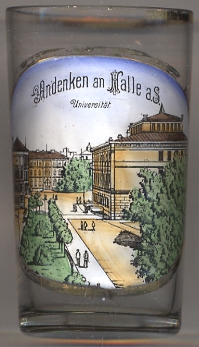
The  University of Halle [left: no. 2767]
was founded in 1694 by Elector Friedrich III of Brandenburg (1701 King Friedrich I in Prussia). The Ratswaage in market square was used as its main building.
Together with the Francke Foundations (founded in 1698) it became a centre of the early German Age of Enlightenment.
In 1806 the university was closed and its building was used as an army hospital. After the Napoleonic times, the university was reopened in 1813/14 and in 1817 was
merged with the university of Wittenberg (today it is named Martin Luther University Halle-Wittenberg).
University of Halle [left: no. 2767]
was founded in 1694 by Elector Friedrich III of Brandenburg (1701 King Friedrich I in Prussia). The Ratswaage in market square was used as its main building.
Together with the Francke Foundations (founded in 1698) it became a centre of the early German Age of Enlightenment.
In 1806 the university was closed and its building was used as an army hospital. After the Napoleonic times, the university was reopened in 1813/14 and in 1817 was
merged with the university of Wittenberg (today it is named Martin Luther University Halle-Wittenberg).
The picture on glass no. 2767 shows a view of  Universitätsplatz
Universitätsplatz Löwengebäude
Löwengebäude
[https://de.wikipedia.org/wiki/Halle_(Saale), https://de.wikipedia.org/wiki/Martin-Luther-Universität_Halle-Wittenberg, http://en.wikipedia.org/wiki/University_of_Halle-Wittenberg]
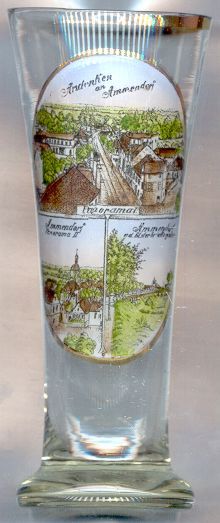
Ammendorf had become an independent parish in 1389. Together with thirteen other municipalities the town became part of Halle (Saale) in 1950.
![[scale]](lineal.jpg)